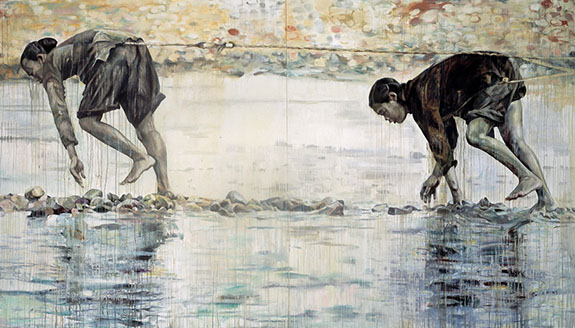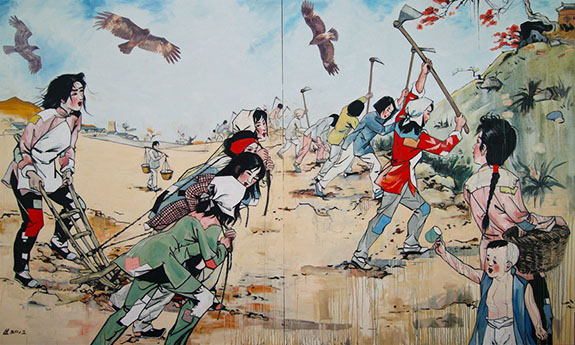by David M. Roth
 |
Hung Liu was the first artist of her generation to leave China for the U.S. She did so in 1984, eight years after Mao Zedong’s death when many Chinese were wondering what would come next. In the absence of a leader whose dictates ruled every waking moment of Chinese life, many artists felt adrift, unsure, even, of what thoughts were permissible. Liu was among them. Defying Mao’s order to look forward, Liu, 65, has always insisted on looking backward, and that proclivity, on view in this tightly focused career retrospective (Summoning Ghosts: the Art of Hung Liu) shows her to be one of the world’s great history painters.
.jpg) |
A key turning point in the Oakland artist’s evolution was her decision, upon emigrating to the U.S., to study with Alan Kaprow, the father of Happenings, at U.C. San Diego, where she also met her future husband, the critic Jeff Kelley, now a leading authority on contemporary Chinese art. Kaprow, a radical thinker, opened Liu’s eyes to the possibilities of process, performance and installation, and how ideas can be conveyed by means other than conventional objects. A companion exhibit at Mills College Art Museum, which preceded this one and recreated two major installations that debuted years earlier in San Francisco and Beijing, proved that Liu had fully absorbed Kaprow’s lessons into her own aesthetic sensibility. She also, henceforth, incorporated into her already substantial vocabulary, select bits of the post-WWII canon, most notably shaped canvases and found objects. Her trademark drips, which cleave almost every painting, are a defining feature. They integrate representational and abstract elements and evoke, in visceral terms, the impact of time, memory and loss by, in essence, substituting thinned paint for tears. These cascades of dissolving pigment have a bifurcating effect. They simultaneously obscure and intensify our view of her subjects by forcing us to look through time. The route the eye travels is laced with pleasures. Faces, bodies and clothes are, for the most part, rendered realistically, whereas the grounds on which they appear oscillate between thin washes and layered globs, splotches, scrapes, mottles and bold gestures executed in varying thicknesses. Oftentimes subject and grounds intertwine. Which means that deciphering the pictures’ structure mirrors the effort of projecting oneself backward and forward in time. Thus, in Liu’s art, ends and means align.
 |
 |
During the so-called Great Leap Forward, for example, when Mao attempted to revamp Chinese agriculture by placing urban technocrats in positions of power, millions starved. That may well be the backstory to Mu Nu (Mother and Daughter) from 1997. In it, two women attached by ropes, strain on hands and knees to pull a heavy load or a plow. The point of this searing image, which calls to mind slavery and extreme poverty, is that they’re performing the labor of oxen or machines. In a series based on Daughters of China (1949), a film in which female soldiers are shown drowning themselves rather than surrendering to Japanese invaders, Liu paints the scenes, based on real events, pretty much as they were filmed. Mixing pathos and heroism in equal measure, they convey, through anguished faces and drip-riven grounds, the emotional impact the film must have had on Liu when she saw it as a child. Arise Ye Wretched of the Earth (2007), with its tapestry-like foreground, is a particularly affecting work from this series; its blurred faces, atypical of Liu, call to mind another history painter who leans heavily on obfuscation to evoke faded memories, Luc Tuymans.
 |